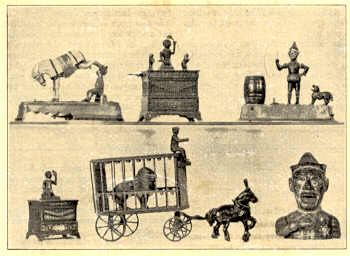The SAVINGS BANKER, January, 1937
Children's Banks of Other Days
By Mrs. George Thompson
A
collection of children's toy banks belonging to Mrs. George Thompson,
author of this article, displayed by the Union Dime Savings Bank in New
York, is arousing great interest among bank visitors. Other New York
banks will show the collection at a later date. — Ed.

Reading left to right —
Upper row: "Always did 'spise a
Mule" Mule kicks colored boy over; Organ Bank — Boy takes off hat
-small figures turn around; Clown and Trick Dog — Dog jumps, throwing
money through hoop and into barrel.
Lower row: Another Organ Bank — boy lifts
hat; Circus Wagon — Lion in wagon — Lion is the bank; The Jolly
Nigger — Put penny in hand and he puts penny in his mouth.
ESPECIALLY
during the last century, the attempt was made to stimulate the
imagination by visible objects. A hundred years before, the
Staffordshire and Chelsea factories copied famous pieces of sculpture in
china, probably because photography was then In its infancy. Then the
idea grew and changed, and objects of an educational nature were made.
The first toy banks were manufactured in the hope of encouraging thrift,
especially in children. These banks were made about 1830; were
non-mechanical, and for the most part were made of tin. They proved so
successful that they were improved upon and the first mechanical banks
were made in the 1860's. Many a child would put his pennies in a bank
that afforded him the amusement of seeing a mule kick his master, or an
elephant lift a small negro boy from the ground. This same child would
not be easily persuaded to save his pennies from a sense of duty, but
once started, the saving habit grew. It was interesting to count the
contents of the bank, and when it had reached a goodly sum, to take it
to the real bank and start saving again in the toy one.
The craze grew and banks were made depicting
famous characters of the day — Boss Tweed, Lincoln, Garfield — some
being made in caricature; others in sincere admiration. The interest
reached its height in the '80's and practically died during the '90's,
and was forgotten by 1900. Now it has revived, and many old banks are
being reproduced and new ones made.
It is a most valuable hobby to encourage. What
child thinks of saving his pennies without a bank? Whereas his first
thought in looking at a bank is to put in some money and observe its
workings. The interest and object of these collections is to encourage
thrift ort the part of both old and young.
|

